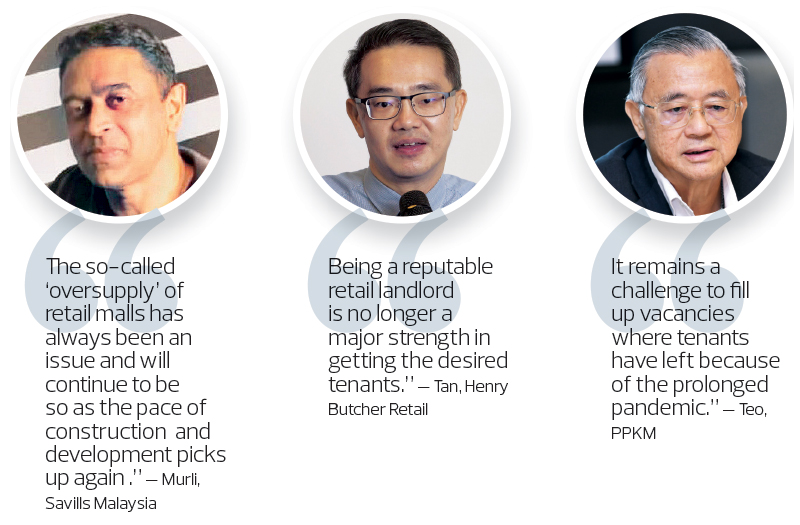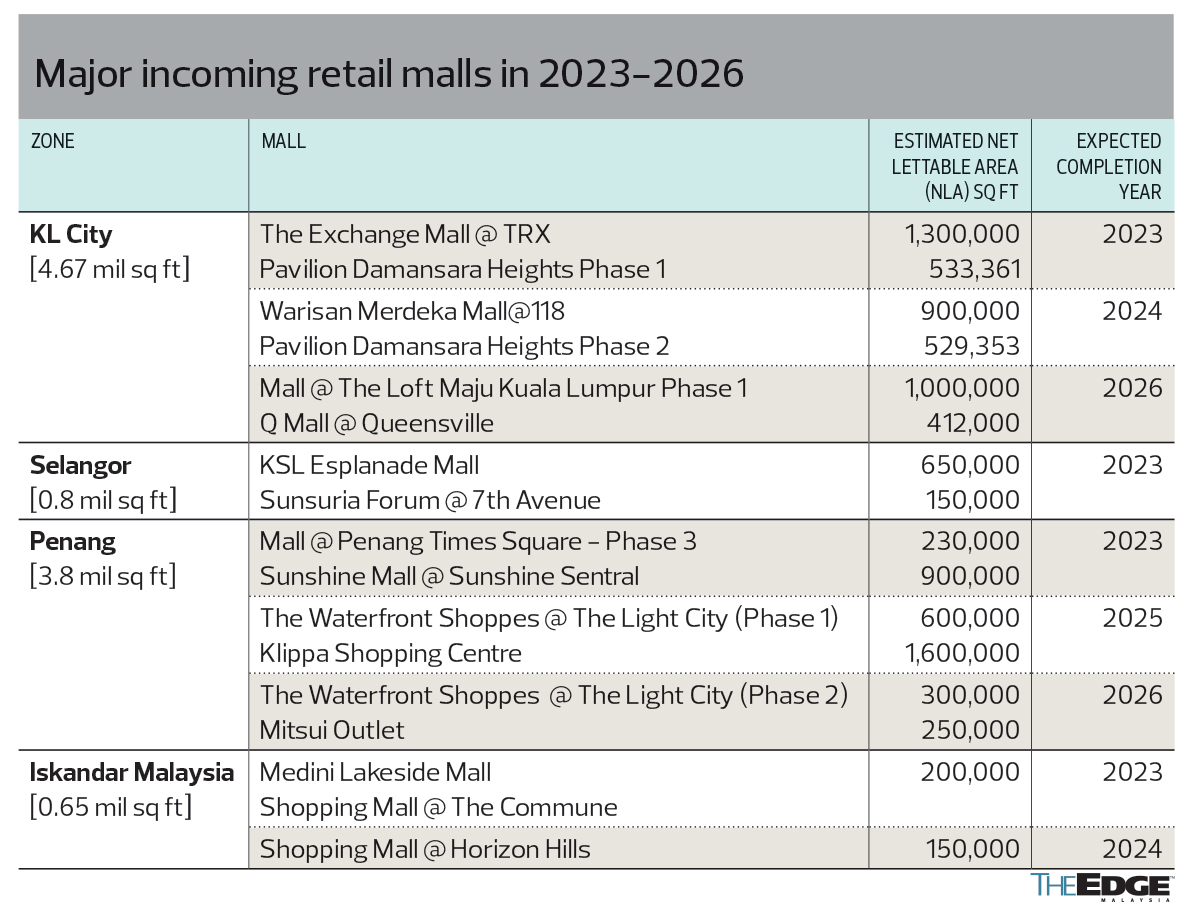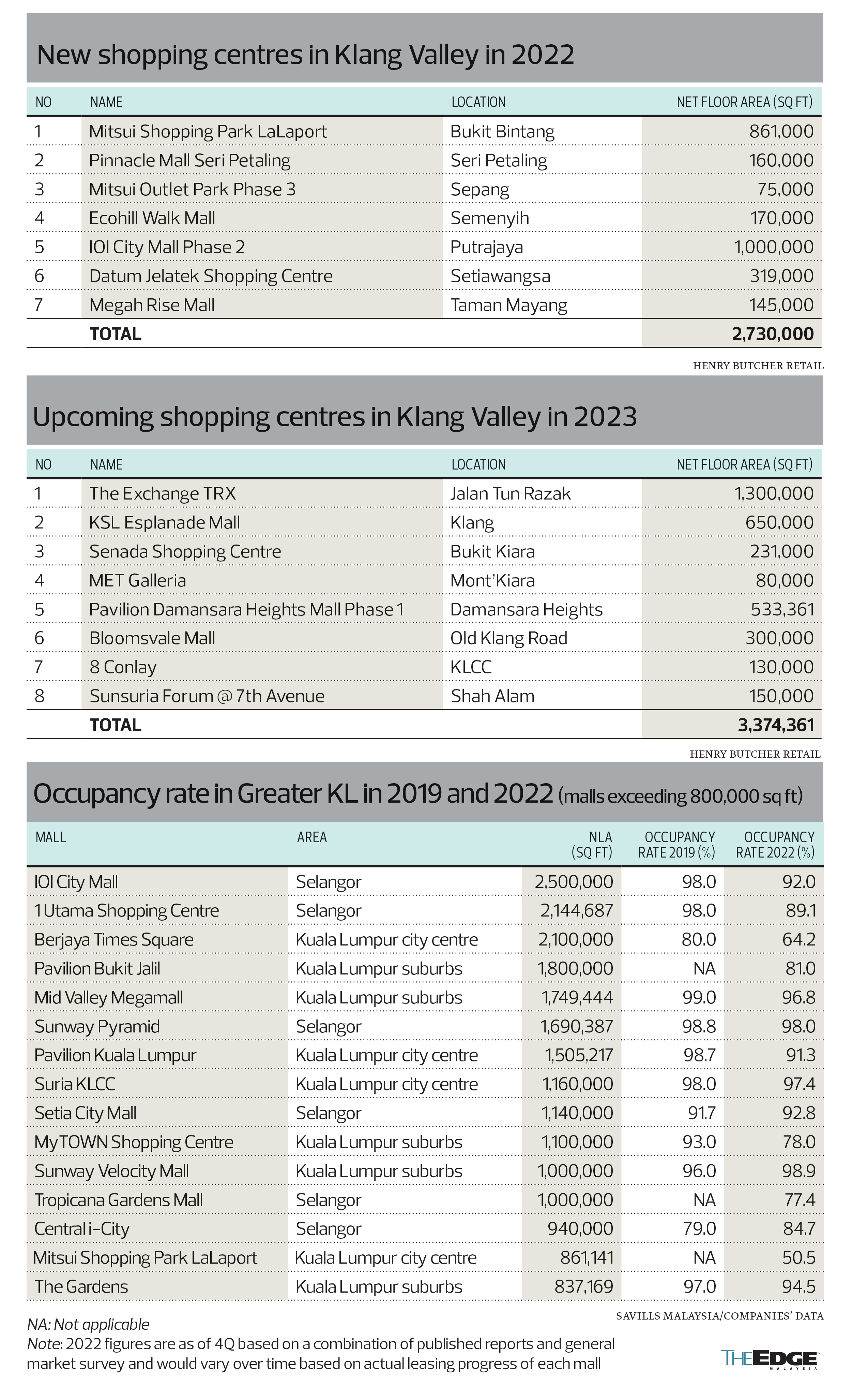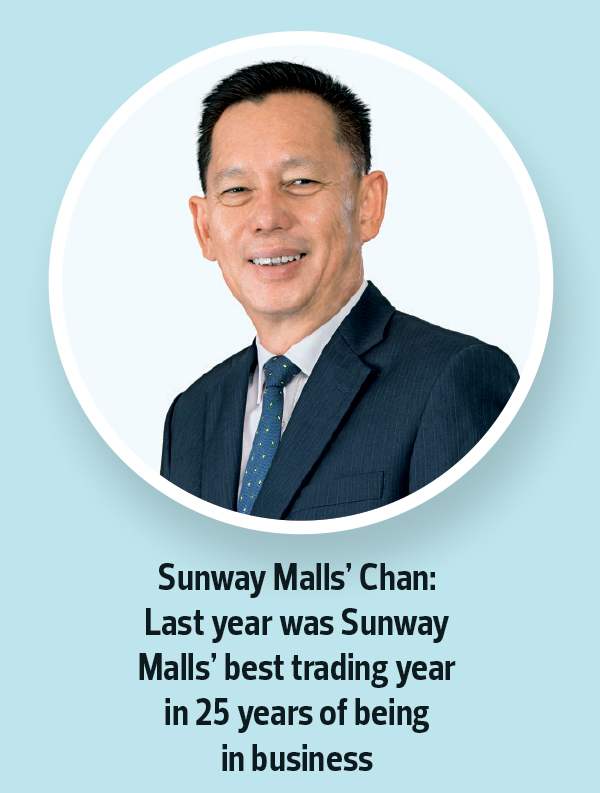
This article first appeared in The Edge Malaysia Weekly on March 13, 2023 - March 19, 2023
KLUANG Mall, Johor is currently enjoying 99.3% occupancy and has a list of brands awaiting a spot in the mall. Even during the challenging Covid-19 pandemic period between 2020 and 2022, this secondary city mall managed to hold occupancy at a commendable level of between 97.8% and 98%.
The mall’s CEO and executive director Tey Fui Kien attributes the improvement and tenant mix to retailers finding Kluang a safe sanctuary for expansion as well as the mall’s efforts to differentiate itself. With 360,467 sq ft in net lettable area (NLA), it is the largest mall in Kluang, serving a population of 323,000.
In 2022, the mall’s revenue not only rebounded faster than expected, but also exceeded the pre-pandemic levels of 2019. In contrast, many malls located within the Klang Valley are finding it a challenge to fill up the retail space.
New malls are opening with a significant number of vacant lots as retailers remain cautious of expansion as they emerge from the devastation caused by the Covid-19 pandemic. A combination of an oversupply of retail space, a labour shortage and a capital crunch faced by retailers is contributing to these vacancies. But the glut in retail has been compounded by the incessant flood of new space.
Last year, the Klang Valley saw the addition of some 2.73 million sq ft in NLA with the opening of seven malls. This year, another eight malls are scheduled to open, which will add an additional 3.37 million sq ft — about the size of three Suria KLCC malls — in the Klang Valley (see table).
Next year, new mall openings include the 900,000 sq ft Warisan Merdeka Mall and 529,353 sq ft NLA Pavilion Damansara Heights Phase 2; while in 2026, confirmed openings include the 412,000 sq ft NLA Q Mall @ Queensville and one million sq ft Mall @ The Loft Maju Kuala Lumpur Phase 1.
“Recent mall openings as well as extensions have been at below 50% as far as opening occupancy is concerned,” Murli Menon, director of retail services at Savills Malaysia, tells The Edge, adding that sign-ups are higher.
Major recent openings in the Klang Valley include Phase 2 of IOI City Mall in August 2022, with one million sq ft in NLA, and Pavilion Bukit Jalil in December 2021, with 1.8 million sq ft in NLA (see table).
Commenting on the openings, Murli says, “IOI [City Mall] has had a strong performance over the years [for Phase 1]. It is one of the top five malls for most brands, be it fashion or F&B; and hence, it is expected that Phase 2 will pick up strongly as well.”
He adds: “Although Pavilion Bukit Jalil opened with less than 50% occupancy, it has been improving since the time it opened.” Occupancy at the mall is now around 81%.
But this is not a universal experience as not many malls will find it easy to fill their vacant lots.
Murli explains that low occupancies were also due to recent launches taking place right after the reopening of markets following the prolonged lockdown.
“Retailers have been or are still in recovery mode from the losses that had accumulated during the pandemic and are therefore seeing pressure on cash flows and pressure when it comes to capex budgets.”
Thus, retailers have become more prudent and extra careful in selecting locations for expansion.
“Shortage of retail labour, construction workers as well as logistics delays are other factors that have affected openings,” Murli adds.
The labour shortage in retail, for instance, includes a shortage both in frontline staff as well as workforce for construction/fit out.
Difficulty filling the space continues to plague many operators even though operations have resumed to pre-pandemic levels. Malaysia Shopping Malls Association (PPKM) president Tan Sri Teo Chiang Kok tells The Edge that footfall is back to normal at popular malls, noticeably during the recent festive periods.
But overall, Teo says, it remains challenging to fill up vacancies where tenants have left because of the prolonged pandemic. And filling up vacancies is an important factor to attract shoppers.
“There are two challenges to filling vacancies. First, to fill vacancies arising from tenants closing during the pandemic and, second, to seek new brands and players. To attract such tenants, malls may have to offer to bear some capital expenditure (capex); for example, shop renovation and offer more flexible rental rates,” Teo says.
Oversupply of malls in Klang Valley to continue
Although the impending glut in retail space was obvious from as far back as nearly a decade ago, stakeholders have chosen to ignore the issue.
“Not surprisingly, one of the factors causing this [difficulty in filling up retail space] is too many malls. The so-called ‘oversupply’ of retail malls has always been an issue and will continue to be so as the pace of construction and development picks up again,” Murli points out (see “Why are malls still being built when there are already so many?” on Page 64).
Henry Butcher Retail managing director Tan Hai Hsin says the Klang Valley started experiencing an oversupply of malls about eight years ago but we continued to open more malls.
Tan agrees that the oversupply of retail space is contributing to the inability of malls to fill up such space.
“In recent years, many shopping malls in the Klang Valley have opened with many vacant units [which are usually allocated] for specialty stores. Landlords are able to secure large anchor tenants but face great challenges in filling up hundreds of specialty stores. The situation will continue for upcoming large shopping centres,” Tan cautions. “The current shopping traffic of all major shopping centres may be back to the 2019 level, but occupancy and rental rates of shopping centres are not.”
Nevertheless, Tan is optimistic a full recovery in rent will take place this year.
And, as more malls open — often not far from one another — the end result is cannibalisation. According to Tan, cannibalisation, which has been around since a decade ago, is also contributing to malls having many vacant lots on opening.
“Market cannibalisation has led to shopping centres being unable to fill up retail shops. Although the retail market has been highly competitive over the past decade, major shopping malls are finding greater challenges in filling up shops in recent years.”
Murli adds that cannibalisation has been and will continue to be there as it is a natural process of weeding out the weaker players, and that end customers will ultimately decide who is able to stay on and sustain in the long run.
Tenants more choosy about expanding
Murli observes that tenants have become selective when expanding, given the challenges. “Tenants have become more picky and careful in the overall retail expansion plan and site selection process,” he adds. “There is also a longer process as far as negotiations for commercial terms are concerned.”
However, he says strong malls/retail podiums with a well-established shopper base can still be selective while considering options for tenant mix. “There is a willingness to consider relatively new players, provided that they have a strong concept or are backed by a team with good credentials and retail experience.”
So, how has the current situation impacted rental terms and rates?
Terms are more realistic and practical, rather than one-sided, Murli says. He cites the example of well-established brands evaluating all proposals with an additional sensitivity analysis to ensure that the business and commercial model is sustainable in the long run, even in the event of a downturn with projected sales drops of 30% or more from baseline projections.
“Wherever possible, there are also safety nets being posed in terms of opportunity cost caps,” he adds. “Thanks to the pandemic, retailers have now become more open to the concept of percentage of turnover as a component of rent so that there is a potential upside to the landlord as the sales increase — this, of course, also requires greater and complete transparency as far as sales information and data are concerned.”
As a result, he says, more malls are integrating the point-of-sale (POS) system for individual tenants with their central system so as to be able to track the sales performance of each retailer — apart from assisting in the calculation of percentage of gross turnover rental, this also provides useful data for both landlord and retailer in analysing the performance of individual tenants/categories as well as that of zones within the malls. This helps the mall to work out relevant marketing and promotional programmes.
Tan agrees that while there are no major changes in rental packages, “more retailers are willing to get involved in turnover rent”, noting, “This change in attitude started during the Covid-19 pandemic.”
He points out that being a reputable retail landlord is no longer a major strength in getting the desired tenants.
“Many shopping centres owned by established and reputable landlords are suffering from a high number of vacant units for a long period of time.”
He also observes that in 2022, rental rates of prime lots in shopping centres rose because many retailers, especially those located on higher floors that suffered during the lockdown, preferred to pay higher rent for premium shops rather than cheaper rent on upper levels. As a result, rental rates on upper floors of shopping centres have declined.
On the issue relating to rental rebates, the experts differ in opinion. Tan says rent is no longer the most attractive tool to attract the right tenants. Low rental rates, free rental for six months (for some, for up to two years) and renovation subsidy do not contribute to higher occupancy rate at shopping centres. “Many established retailers and branded retail operators are no longer attracted to these types of rental offers.”
However, Murli says that with the exception of top malls where space is still a premium, he is seeing instances of capex contribution from landlords for well-established and strong brands in the form of cash or rental rebates. Some tenants are demanding an increased rent-free period, especially in the early stages post-opening of new malls, and this is usually tied to the occupancy rates of the newly opened malls.
He adds that the Klang Valley malls face greater pressure in securing tenants when compared with malls outside the area, given the huge supply of existing malls and retail space in the former, resulting in retailers and shoppers being spoilt for choice.
“Smaller towns/secondary cities have started becoming strategically more important for brands while planning out their retail distribution road map. Thanks to the spread of digital media and online/e-commerce, many of these markets have now been exposed to more brands and concepts, thereby fuelling the latent demand in these cities,” he notes.
Kluang Mall, for example, managed to secure 30 new brands, including Texas Chicken, Golden Screen Cinemas and llaollao, when the markets reopened following the pandemic.
Malls allowing temporary leases to fill up space and increase foot traffic
Malls that are unable to secure permanent tenants are trying to fill up shops on a temporary basis by holding events and promotions, thereby increasing shopper traffic. Tan says a popular event held at malls is anime and cosplay, and that these events and promotions also occupy mall atrium space, exhibition halls and even vacant shops.
Online retailers are coming out to meet their regular customers as well as to reach out to new ones by way of farmers’ markets, flea markets, bazaars, kiosks, promotion space, pushcarts and pop-up stores to sell their products and services directly to shoppers.
Tan observes vacant lots are leased to temporary tenants as pop-up stores. The lease may be for just a week, a month or three months; some for one year. Typical mall tenancies are for a three-year period.
Save by subscribing to us for your print and/or digital copy.
P/S: The Edge is also available on Apple's App Store and Android's Google Play.





